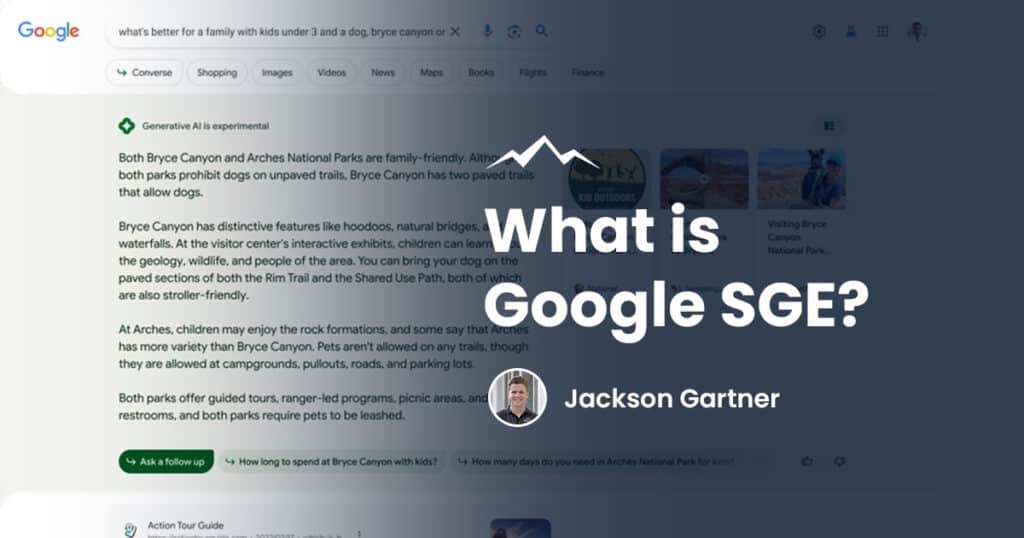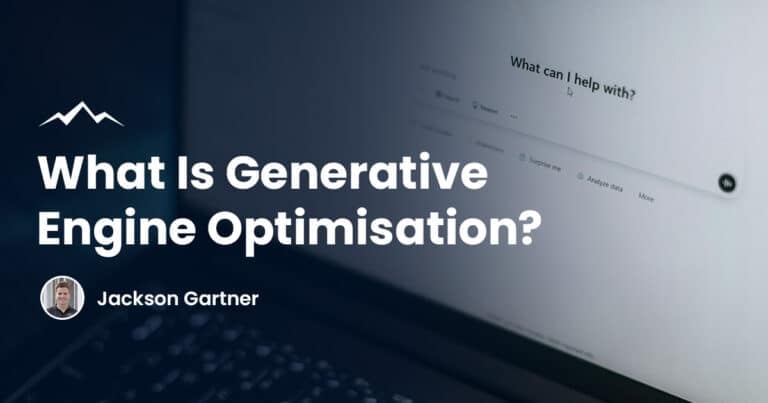Artificial intelligence (AI) is transforming digital marketing, making repetitive tasks easier and more accurate.
Among the countless new tools coming out, Google’s new Search Generative Experience (SGE) is set to become the new norm for online search platforms.
As agencies harness the power of generative AI they must also navigate its risks, such as data overreach and bias.
With the right approach, these challenges can be managed so that you can fully tap into AI’s benefits without compromising on quality or ethics.
The Search Generative Experience takes search capabilities further by understanding user intent in unexpected ways.
Let’s look at how SGE works, why it was developed and what it means for consumers and businesses alike.
From altering SEO strategies to reshaping online consumer behaviour, Google SGE presents unique opportunities and challenges that you need to be across.
What is Google’s Search Generative Experience (SGE)
Google’s new Search Generative Experience aims to answer your questions accurately while also attempting to anticipate what you might want to ask next. Google Search Labs has developed this new tool using the power of AI to modernise how we search online.
This tool, driven by Google’s own in-house generative AI, works by analysing your queries and serving up additional related questions that can deepen your understanding or lead you down new paths of enquiry.
The large language model known as the Pathways Language Model 2, or PaLM 2, will make it possible to feel like you’re chatting with someone who’s read everything on the internet.
The natural language processing capabilities of the PaLM 2 technology allow the search engine to understand human speech as naturally as another person would.
This means that when you ask something, SGE doesn’t just see words in isolation. Rather, it fully grasps the context and intent, thereby being able to deliver richer and more intuitive search results.

Why Google SGE Was Developed
Imagine a world where every online search feels like you’re conversing with a savvy friend who knows your tastes and interests. That’s the vision behind Google’s Search Generative Experience.
The development of SGE is rooted in evolving user expectations for more intuitive and interactive search experiences.
As people have grown accustomed to digital assistants that understand natural language, there’s been an uptick in demand for similarly smart capabilities within search engines.
The numbers tell us this story clearly: as much as 27% of the global online population uses voice search on mobile, highlighting the shift towards conversational interaction with technology.
Google noticed that its users were looking not just for information but also for guidance through their decision-making process.
Google SGE was born out of the need to address these trends. It leverages artificial intelligence to compute human questions with remarkable nuance.
It even suggests follow-up questions before you even think to ask them. This anticipatory feature could redefine how we interact with our digital devices.

What Google SGE Can Do
Think of Google’s Search Generative Experience as a personal digital librarian, one that doesn’t just find books but also suggests which chapters to read.
Unlike traditional search engines that serve static results, Google SGE actively interacts with user queries. It’s a conversation starter, asking follow-up questions to narrow down precisely what you’re looking for.
With its advanced generative AI algorithms, Google SGE can understand complex and detailed questions and then provide comprehensive answers that often anticipates the additional information needed before you even realise you need it.
The difference here is clear. Where regular searches drop you at the door of knowledge, Google SGE invites you in and gives you a guided tour.
It’s not about flooding users with data but rather about crafting responses tailored to their unique informational journey.
Impact of Google SGE on Consumers
Think of the last time you searched for a new phone online. You likely had to sift through pages of content, piecing together bits of information from different sources.
Consumers can now get personalised and dynamic search results that understand not just keywords but the intent behind them.
This means when you ask about smartphone battery life, Google SGE doesn’t just throw specs at you. Instead, it guides your journey towards understanding what those numbers mean in real-world scenarios and why they’re important to you.
This generative AI-driven approach can even lead consumers down unexpected paths, presenting products or ideas they hadn’t considered before. As such, shopping becomes a more exploratory search experience which will have a huge impact on eCommerce SEO.

Impact of Google SGE on Businesses
The rollout of Google’s Search Generative Experience will be a game-changer in digital marketing, especially for Google Advertising. It will alter how consumers engage with search engines, and businesses need to stay sharp if they don’t want to be left behind.
With Google SGE, users will get more detailed AI-powered search results that could lead to fewer clicks into a specific website.
For starters, think about website SEO as it is now. It’s all about keywords and backlinks. However, with Google SGE, we’re looking at a scenario where user intent becomes even more critical.
This AI-driven system doesn’t just match keywords. It understands context, serving up content that fits what the searcher really wants.
If you’re savvy enough to optimise your website copy for relevance and are not just cramming in keywords, you could see your site climb in search engine results while competitors fall behind.
How Can Businesses Take Advantage of Google SGE?
By leveraging this AI-powered search tool, companies can ensure they’re not just a blip on the radar but rather a meaningful contributor.
If your business can publish useful content that anticipates and answers follow-up questions with accurate research and a deep understanding of your target market then you will do well.
This means diving deep into topics with comprehensive detail that satisfies both immediate and subsequent user curiosity.
Your initial information should break the ice, leading users further along their quest for knowledge and slowly directing viewers to your services or products.
But there’s more than just feeding the algorithm what it wants. Smart businesses will use Google SGE data insights to fine-tune their approach, making sure every piece of content has precision targeting behind it.

Impact of Google SGE on Website SEO
There is no doubt that Google SGE will reshape SEO.
Traditional keyword optimisation won’t cut it anymore. Instead, content must be more conversational and answer questions users haven’t yet asked.
It’s about anticipating needs with precision. The AI text snippets that users get from their Google SGE searches will impact organic search traffic significantly with fewer people needing to open a website to get the answers they need.
To stay visible in organic search results, businesses have to rethink their strategies from the ground up because what worked yesterday may not work tomorrow.
Correct use of structured data will become critical so that the AI can find your content more easily and deliver it to your target audience as part of its response.


Downsides of Google SGE
While innovative, Google SEO isn’t without its faults. For one, it heavily relies on machine learning algorithms that might not always grasp the nuance of human language.
This can lead to misunderstandings or inaccurate responses to search queries but user feedback should help improve this over time.
Additionally, because these kinds of language models learn from patterns in the data they’ve been fed, there’s a risk of perpetuating biases present in that data.
Another concern is privacy, Google SGE works by analysing vast amounts of user data to predict and personalise results more effectively than ever before. However, this raises questions about how much personal information is being collected and how securely it’s stored.
Lastly, there is the market disruption that Google SGE will cause. With such powerful technology in play, smaller businesses may struggle to keep up with the SEO game, meaning potential visibility issues unless they adapt swiftly.
Upsides of Google SGE
The launch of Google’s Search Generative Experience will open up search opportunities with AI-powered insights that are more intuitive and responsive than ever before.
Where SGE shines is when it comes to understanding user intent. Instead of just matching keywords to find the relevant subject matter, it reads between the lines to understand what users really want.
It’s not just about being in the right place at the right time. It’s about creating a space where your business becomes impossible to miss.
SGE suggests follow-up questions too, which can help guide users through their search journey seamlessly from query to conversion.
For businesses that are ahead of the curve and ready to harness this feature, online engagement through Google search results could soar.
Final Thoughts
It’s very likely that AI-powered search engines such as Google SGE are inevitable. Therefore, I would recommend working with your website designer to embrace the change and take advantage of these new opportunities.
The Search Generative Experience is redefining search by offering smarter searches with a deep understanding of intent.
Harness this potential to get ahead. It’s all about adapting SEO strategies and meeting consumers where they are, which means knowing your target audience.
While there are some difficulties ahead as the world grapples with this new approach, such as ensuring relevance and combating biases, these can be managed for maximum advantage.
Get ready for a new era in online organic search by embracing Google SGE, or risk a decline in your online visibility.
Frequently Asked Questions
What is Google’s Search Generative Experience (SGE)?
Google’s Search Generative Experience is a new search platform powered by artificial intelligence, specifically designed to improve how we search online by understanding and anticipating user intent. It leverages advanced AI models to provide dynamic, conversational, and intuitive search results.
How does Google SGE work?
Google SGE utilises the Pathways Language Model 2 (PaLM 2) to analyse search queries and provide relevant follow-up questions and answers. This generative AI model understands context and user intent, enabling it to deliver a more interactive and refined search experience that feels like conversing with a knowledgeable friend.
What are the benefits of Google SGE for consumers?
For consumers, Google SGE offers a personalised search experience that goes beyond simple keyword matching. It provides dynamic results that not only answer direct questions but help them make better-informed decisions and discover new interests.
How will Google SGE impact businesses and their digital marketing strategies?
Google SGE will significantly impact digital marketing by changing how consumers interact with search engines. Businesses will need to adapt their SEO strategies to focus more on user intent and context rather than traditional keyword stuffing.
Content should be more conversational, informative, and anticipatory to meet the sophisticated capabilities of SGE.
What are the potential downsides of using Google SGE?
Potential downsides of Google SGE include issues related to privacy, as the system relies on analysing extensive user data to predict and personalise search results. There is also a risk of perpetuating existing biases if the AI learns from skewed data sets.
Additionally, the advanced capabilities of SGE might cause smaller businesses to struggle with visibility unless they adapt swiftly to these new SEO dynamics.
How can businesses optimise their content for Google SGE?
Businesses can optimise their website content for Google SGE by focusing on creating detailed, relevant, and contextually rich content that also anticipates and answers potential follow-up questions.
Utilising structured data and schema markup can also help the SGE system better understand and feature your content in search results, enhancing visibility and user engagement.
To your success,
Jackson




